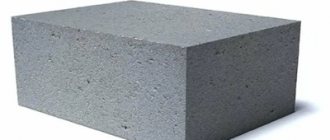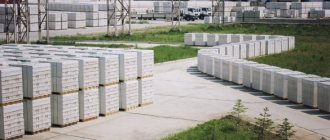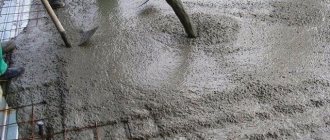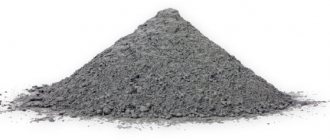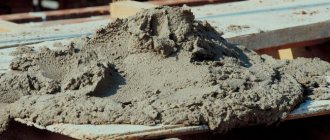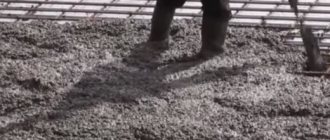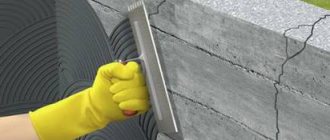When performing finishing work, there is often a need to seal joints, seams, and cracks. Most often in such situations, a very popular acrylic sealant is used. It helps protect certain areas from temperature changes and the harmful effects of moisture. This product adheres well to many building materials, lasts a long time, and is considered safe for human health. Before using this product, it is important to become familiar with its advantages and disadvantages.
Acrylic sealant is designed for filling cracks and sealing various seams Source i.ytimg.com
Characteristics of acrylic sealant
A modern product containing acrylic is intended for moisture insulation and sealing of various joints. It is perfect for inexperienced users: it is easy to use, does not harden for a long time, thanks to which the position of the seam can be corrected. This composition is quite elastic, easily adapts to slight vibration, and after drying it can be plastered or painted.
Acrylic sealants are used to fill gaps and cracks: you just need to pour them inside and wait until dry. The material retains its characteristics indoors and is not afraid of temperature fluctuations or changes in humidity. Street conditions are less favorable for such compositions: in severe frost they (in the absence of special ingredients) become hard and sometimes crack.
Most acrylic sealants are waterproof, but they lose their properties when constantly exposed to moisture Source mirsmazok.ru
Technical specifications
The quality of acrylic sealants is assessed by an important indicator: elongation at the maximum possible stress. When a product is stretched while simultaneously subjected to excessive stress (more than the maximum permissible value), it will begin to become irreversibly deformed. As the number increases, the elasticity of the acrylate sealant increases. High-quality compounds have an indicator of 10% and above. When the mark on the package is 11%, they are already allowed to be used outdoors. Additionally, it is worth noting the following characteristics of acrylic-based sealants:
- permissible seam width is 0.6-5 cm, optimal thickness is correspondingly half that;
- operating temperature – from -20°С to +70°С;
- film formation time – 15 minutes;
- the period of adhesion of acrylic sealant to the base is no more than one hour;
- Drying time – 24 hours at humidity 50%, temperature 23°C;
- frost resistance (for a separate group) – more than five freeze-thaw cycles;
- break rate – 500%.
After curing, the acrylic sealant acquires optimal strength and resistance to deformation loads Source i.ytimg.com
Common seam sealing methods
If cracks begin to spread throughout the concrete, then it is not enough to decide on a suitable composition, since you still need to choose the optimal technology. Today, the following methods are used to repair and eliminate seams on a concrete surface:
- Injection of the mixture, which is supplied by special mechanisms into the depth of the formed crack.
- The use of solutions based on a cement-sand mixture (CSM) with polymer additives. Subsequently, the surface to be repaired is treated with polyurethane sealant.
- Shotcrete using special compositions, the main ones of which are CPS and bitumen additives.
Of these methods, the most effective is injection. Its use involves creating deep holes directed at an angle to the defective area of the concrete surface. Using special devices, a solution is injected into the prepared holes, which is made on the basis of synthetic resins. The mixture gradually gains strength, which will eliminate all defects and extend the service life of the structure.
Sealing concrete joints.
If small cracks (no more than 4 mm thick) appear on objects of personal use (apartment, cottage, or just a balcony), then these defects can be eliminated with repair mixtures based on epoxy glue and DSP. Proper preparation of the solution will allow for rapid setting, thanks to which the defect can be completely eliminated.
To strengthen the structure where you found a wide crack (from 4 mm), you need to make a solution based on liquid glass. Mix this product with cement, water and sand in the ratio: 1:1:3:3. Fill the resulting joints with the finished composition and wait until it dries completely. A high-quality mixture will protect concrete from further destruction.
Varieties
Depending on the characteristics of operation and chemical composition, modern acrylic sealants are divided into groups.
Frost-resistant
The products are resistant to precipitation, aggressive external influences, and negative temperatures. They have significant elasticity and retain their integrity in the event of freezing. Most products are recommended to be used at -20°C and above, but there are more frost-resistant sealing mixtures. With their help, it is possible to process seams between logs and concrete slabs.
Frost-resistant acrylic sealant can be used for external repair and construction work in regions with very cold winters Source kraska.guru
Moisture resistant
They differ in their composite composition (silicon and rubber are added) and often contain other components that significantly improve the quality of the product. They are well suited for different purposes in rooms with high humidity (bathroom, kitchen). Compared to ordinary acrylic joint sealants, moisture-resistant products are better able to withstand temperature fluctuations and have fairly high adhesion to other building materials.
Moisture-resistant acrylic sealant is not intended for use in conditions of constant contact with water Source kraska.guru
Non-moisture resistant
Suitable only for interior work in conditions of normal or low humidity. They are often used when performing minor repairs, gluing baguettes and baseboards. Such products are recommended for use on concrete, brick, and wooden surfaces.
Non-moisture-resistant acrylic sealant is intended for rooms with normal humidity, is highly durable and resistant to fading Source elnik.com.ua
Video description
How to strengthen concrete that is peeling off from the base is described in the video:
Having found out why the floor screed cracked and what to do, you can begin repairs.
- First, by tapping, areas of delamination and voids are identified and marked with chalk.
- In the marked places, holes are drilled in the screed at a distance of 15-20 cm from each other.
- After cleaning and priming, an epoxy mixture is poured into the holes.
- It also seals cracks.
- After the mixture hardens, the holes are filled with liquid cement mortar.
It is important! This method cannot be used if a water or electric heated floor system is installed in the screed, or other communications without an accurate wiring diagram.
When drilling repair holes, there is a high risk of damaging the cable Source sense-life.com
Color variety
You can often see white or colorless acrylic sealants in hardware stores. They are extremely popular among users because they fit perfectly with various plumbing fixtures and tiles. It is important to note that transparent compounds are hardly noticeable on treated surfaces. If you want to choose a sealing material that matches the color of the base, you need to buy a pigmented product of the desired color. There are also products in wood shades: oak, walnut, cherry, wenge and others.
A wide range of colors of acrylic sealants for wood makes it easy to choose the material that matches the color when processing any base. Source st3.stblizko.ru
How to repair cracks in a concrete floor - just about the sore point
Concrete surfaces have gained popularity due to their great strength, which is why concrete is used in many areas of construction. However, even such a durable material can crack and split if not properly maintained and other factors occur.
How to repair cracks in a concrete floor, and how to prevent their occurrence, let’s take a closer look at this pressing issue from all sides.
Advantages and disadvantages of acrylic sealants
Using acrylic in repair work has a number of advantages. The main advantages of products containing it are:
- affordable price;
- wide choose;
- easy to use;
- the ability to correct defects;
- environmental friendliness;
- fire safety;
- do not turn yellow after a while;
- high adhesion to other building materials;
- Painting, puttying, mechanical processing of the seam is allowed;
- good vapor permeability;
- UV resistance;
- the ability to update damaged areas.
The main disadvantage of acrylic sealant is its intolerance to frequent contact with water. Being in a very humid environment, it gradually dissolves, and the seam accordingly deteriorates. Moisture-resistant materials can come into contact with moisture only after final drying. But with constant exposure to liquid, they lose their characteristics over time.
Vapor permeability is an important characteristic of acrylic sealant, which does not allow moisture to accumulate indoors Source omega-gc.ru
Thiokol polysulfide (Sazilast)
Flowable thiokol sealants are based on polysulfides, characterized by elasticity and resistance to industrial oils, alkalis, salt solutions, dilute acids, fuel, and kerosene. These are usually two-component formulations.
Scope of application: the material is used for elastic waterproofing of screed seams located in passage areas (parking lots, garages, airfields).
Advantages:
- After mixing the components, thiokol sealants turn into elastic rubber that does not shrink. These processes occur at normal temperatures;
- cured material - vulcanizate, characterized by air tightness, resistance to ozone, air, moisture, water, oxygen, ultraviolet radiation;
- high deformability and adhesion to concrete;
- corrosion resistance to mineral acids, salt solutions, alkalis.
Flaws:
- high price;
- variation in color and properties in different batches of material.
In principle, we can say that such sealants occupy a special place. They create protection for concrete subject to dynamic and static deformations due to temperature changes, in the presence of aggressive media and solvents.
Specifications
| Tensile strength | 0.5 MPa |
| Modulus of elasticity at elongation | 0.4 MPa |
| Elongation at break | 160% |
| Viability | 2-24 h |
| Application temperature | -15+40 degrees |
| Density | 1450 kg/m3 |
Where are they used?
Acrylic sealants do not contain solvents or harmful components, which is why they are best suited for interior work. Moreover, they can be applied in a closed room. There is no need to use protective equipment.
Acrylate sealants are often used for:
- sealing joints between beams and logs;
- filling joints between concrete elements;
- sealing the places of contact of individual elements with walls;
- replacing construction adhesive (for example, when attaching skirting boards to shelves);
- gluing fillets, baguettes, as well as high-quality sealing of seams between the latter and the base.
Advice! Acrylic sealant can be used for installing ceiling tiles and filling gaps.
Acrylic sealant is often used to seal the places where individual objects come into contact with walls Source gidpokraske.ru
Sealing
The next step after cutting ditches in concrete is sealing them. High-quality sealing is necessary in order to protect the screed from moisture penetration deep into the concrete, as well as to prevent other damage.
There are several options for how to carry out this work:
- use of special sealant - due to its elasticity, mastics are very easy to work with. In addition, they give a good effect and reliably protect concrete from water penetration;
- sealants - the use of various sealing materials is also quite popular. They are especially well suited for making insulation slots;
- special slats are another sealing option. Such strips consist of a metal profile and a rubber lining and can be installed both in fresh concrete and in grooves made after it has dried.
Compensation bar
Whatever method is chosen, it will protect concrete floors only if the work technology is followed
Therefore, it is always important to take your time and follow the manufacturer's instructions
Features of application
The process of applying sealing material does not require special knowledge or tools. You just need to properly prepare the surface of the base: clean it from the accumulation of dirt, grease, and all kinds of old coatings, then dry it thoroughly. When you need to form a wide seam, you must purchase a sealant (for example, polyethylene cord) in advance. It will minimize the thermal conductivity of the connection, make it more reliable, and also significantly reduce material consumption (up to 70%).
Acrylic sealant can be applied without using gloves (it is harmless to the skin). However, it cannot be diluted with any liquid (including solvents). This will significantly reduce the quality characteristics of the mixture and lead to cracking of the seam.
You can apply the composition with a special gun: it is easy to insert cartridges and tubes into it. It is better to spread the sealing agent from a bucket with a narrow spatula; from a tube, squeeze it out in portions onto the required area.
After applying the acrylic sealant, it can be given the desired shape within another quarter of an hour. After the specified time, a polymer film begins to form, so repairing the seam will be difficult and impractical. The hardening of such material continues for a day; at a low temperature, the process is delayed for several more hours.
Independent installation of a waterproof expansion joint with a metal profile
The construction of expansion joints in concrete floors can be carried out using a special metal profile, which is important in industrial premises.
How to make a waterproof seam with a metal profile:
- A long plaster rule or string is used to mark a line for cutting grooves 20-30 wide and up to 4 centimeters deep (corresponding to the height of the metal profile).
- Cutting the seam with a wall chaser (several at once, followed by cutting out the concrete with a hammer drill and cleaning with a cylindrical grinder).
- Carrying out level control using a laser level.
- Filling the bottom of the seam with a layer of reinforced polymer concrete, finishing the surface.
- Inserting special bolts into the profiles, installing them in the correct position, connecting two profiles into a solid structure with fixation with nuts and connecting elements. The distance between the profiles can be different; it is indicated in the project, taking into account the type of expansion joint. Make sure that the bottom plane of the profiles lies without distortions in any direction. The profile fits into place without effort. At the joints of the profiles there is a guide rod and a hole, which guarantee the strength of the connection of several elements into one structure. Before joining, the elements can be coated with high-quality metal glue.
Fastening the profile with dowels, drilling holes of the required diameter on wide horizontal planes according to the size of the plastic elements of the dowels. The approximate depth of the hole that is drilled should be 2-3 centimeters greater than the length of the dowel, then it will be easier to drive it in. Screwing the metal elements of the dowels all the way with an electric drill, checking the quality of fixation. Dowels are attached in increments of 40-50 centimeters. Dismantling the installation kit - removing the nuts and metal tie, which is secured with bushings with internal threads. After unscrewing, the bolts do not need to be cut off, since they are located below the upper plane of the profiles and in the future a decorative insert will be attached to them
On the profiles you also need to unscrew the nuts that temporarily fix the bolts. Laying an elastic replaceable insert: a roll is rolled out along the profile (starting from the end), carefully pressed into the seating protrusions until it stops. The insert should lie flat, without gaps or distortions; the remaining piece is cut off with a mounting knife. Installation of decorative overlays made of stainless alloy steel (most often used for loaded floors) or aluminum
The surface of the pads includes the ends of the mounting bolts. Everything is fixed with nuts, the position is adjustable, eliminating gaps between adjacent elements. Next you need to remove the protective film. Installing a protective cover on the profile (it is removed after the coating has hardened).
.
Consumption of funds
The required amount of acrylic sealant depends on the size of the future seam. In order to calculate it, you should multiply the depth and width of the gap. The result will be an approximate volume of material: it will show the required weight of the product (in grams) per 1 meter.
In the case where the joint is triangular in shape (instead of the usual rectangular), the final value should be divided by two. As practice shows, for 10 m of medium-thick seams, 250 g of sealing compound is sufficient.
Cracks in concrete - leave or repair?
Filling potholes in concrete floors, and even small cracks, requires additional labor and financial costs. It’s especially unfortunate to waste time on such work when deadlines are tight. And such a period in construction, even if it is done on its own, rarely passes.
Therefore, a reasonable question arises: is it generally necessary to seal holes in a concrete floor? This is not a finishing layer, but just a rough one, which will still be covered with several layers of coating.
Important: Moisture is the worst enemy of any material, and especially concrete. It “kills” it slowly but surely, penetrating into every crack and corroding the reinforcement. Even if these changes are not noticeable in a year or two, in the future you can pay heavily for the days saved during construction.
Therefore, any normal master will not only advise you to get rid of any defects on the base, but will also tell you how to repair a crack in a concrete floor of any complexity with your own hands.
Removing traces
It often happens that acrylic sealant accidentally gets on different surfaces. If it has not yet hardened, it is easy to remove. To do this, you need to thoroughly wash the base with soapy water.
Removing hardened material requires the use of a razor or sharp knife. Cut off the product layer by layer and very carefully so as not to damage the affected object. Residues should be rubbed off with fine sandpaper, steel wool or pumice. From delicate surfaces, such a composition is carefully removed with a wooden scraper. After finishing work, wash the cleaned base with a gentle detergent and then dry it.
Fresh traces of acrylic sealant can be easily washed off with water or a gentle detergent Source kraska.guru
Necessary materials
A seam is a cut in the structure of a building. During the sealing process, it is filled with a special material.
Creating seam waterproofing is a painstaking and responsible process, so only proven and high-quality building materials are used for it. Most often used for this:
- Soil mixtures. They contain quartz sand, cement and various special chemical components.
- Waterproofing materials. During construction work, very often minor defects are left unattended, which can lead to negative consequences: the appearance of mold, dampness on the ceiling and walls inside the building. To eliminate them, waterproofing building materials are used.
- Very often, special hydraulic seals are used to eliminate and prevent leaks.
- An excellent option for seam sealing is waterproofing cords. When in contact with moisture, they tend to swell, thereby filling the space and eliminating any leaks. However, it should be noted that this material is only a suitable option for small seams.
- To optimally protect a building from moisture, waterproofing dowels are often used. They also perfectly compensate for the mobility of the structure.
- Special sealants.
To produce this type of waterproofing, special rubber and the latest technologies are used. Highly durable and waterproof, waterstops come in a variety of shapes and sizes, allowing you to choose the right option for any seam.
How to choose a sealant
Usually in stores you can find universal sealing agents, as well as separately for windows and doors. In reality, the difference between them is minimal.
When processing smooth surfaces, it is important to additionally take the following measures: apply a special primer with abrasive particles to the base or walk over it with sandpaper. As a rule, such preparatory procedures are applied to various types of plastic.
Acrylic sealant is suitable for application to window structures: after final drying, it can be coated with suitable paint.
When purchasing a sealant for the kitchen or bathroom, it is necessary to take into account its resistance to moisture and the presence of fungicides in the composition.
When sealing joints in aquariums and shower stalls, it is recommended to use a sealant containing silicone.
In order to seal stoves, fireplaces, and other heating structures, it is better to purchase silicone or silicate compounds that are resistant to the influence of excessively high temperatures.
Polyurethane (Rustil, SOUDAL, Sazilast)
These are sealants for filling joints based on polyurethane resins. Such compositions have been known for a long time, but they became widely used not so long ago - within the last 10 years. Now sealants of this group continue to gain great popularity due to cheaper raw materials and simpler production. The basis of the material is an elasticized two-component or one-component liquid resin .
Advantages:
- high elasticity;
- resistance to fuels and lubricants, alkalis, technical oils, salt solutions, diluted acids, aging, and weathering;
- the material is used as a self-leveling mass for filling floor joints;
- this is an option for internal work on installing elastic waterproofing;
- the surface may be subject to high mechanical loads (industrial, warehouse);
- the material is impact-resistant and wear-resistant, which compares favorably with analogues with a polymer base.
We can say that the properties of the material practically do not differ from batch to batch.
You can work on concrete with two-component compounds (paste and hardener) and one-component ones, which are cured by air moisture
Flaws:
- demands on the dosage of components.
Specifications
| Options | One-component | Two-component |
| Curing time | 75 minutes | 18-24 hours |
| Tensile strength | 0.8 MPa | 0.8 MPa |
| Application temperature | From +5 degrees | -20+40 degrees |
| Operating temperature | -60+80 degrees | -60+70 degrees |
| Density | — | 1460 kg/m3 |
| Consumption | 70-270 g/m.p. | 70-270 g/m.p. |
Differences between acrylate sealant and silicone
Sealing agents containing acrylic or silicone vary in properties and methods of use:
- After final hardening, acrylic seams can be painted in various colors with any water-based acrylate or latex paint. If necessary, treated areas can be easily restored and locally updated. The coloring composition does not adhere well to the silicone base.
- Acrylic sealant can be processed using mechanical methods: drilling, grinding. Silicone in the event of such an impact can completely separate, damaging the connection.
- The elasticity of acrylic is lower than that of silicone. Materials based on the latter are more plastic, give minimal shrinkage, and stretch well (without damage).
- Acrylic sealant is vapor-permeable, silicone is airtight. Therefore, the first does not have a negative effect on the microclimate inside the room.
- The moisture resistance of acrylic is significantly lower than silicone, a completely waterproof material that resembles rubber in its properties. Acrylate products are water-based, so they are subject to gradual dissolution.
- Acrylates are characterized by significant adhesion to porous building materials and are excellent for wooden and concrete bases. On the eve of sealing, smooth surfaces must be sanded to improve the quality of adhesion.
- Regular acrylic sealant costs less than silicone. Typically the difference is about 40%.
- The color range of acrylate products is significantly richer. If necessary, it is possible to select a suitable material of any color, including various types of wood. Silicone compounds are produced only in white, grayish, black, and red colors.
- Silicone lasts up to twenty years. Acrylic begins to lose its properties earlier; after a while it can dry out.
- Acrylates are environmentally friendly: safe for human health and do not harm nature. Silicone sealants made with acids emit an unpleasant odor, which limits their use.
Acrylic joint sealant is best suited for application indoors where the humidity level does not exceed normal values, provided there is no contact with liquid. This product is considered indispensable when the seam is planned to be painted. It is often used to eliminate cracks in window or door structures and seal plumbing fixtures. Silicone products are suitable for external use, bathrooms, sealing the walls of aquariums, and other items in contact with water. However, they cannot be used for processing concrete, stones, and metal bases.
Details
Price
The cost of sealants will directly depend on the composition, brand, and country of origin. If we talk about domestic products, it is natural that they cost an order of magnitude cheaper than imported sealants for concrete and expansion joints in it. In terms of affordability, the leaders are silicone and acrylic compounds, the approximate cost of which starts from 130 rubles per 1 kg. More expensive polyurethane sealant - from 180 rubles per 1 kg. Thiokol products occupied the middle price category - from 200 rubles per 1 kg of mixture. The most expensive type of sealant is silane modified products, and costs from 710 rubles per 1 kg, but the cost is quite justified, because this concrete sealant is waterproof, and is also the most reliable and durable.
Sealing
Any steps to create completely sealed coatings begin with preparing the base. A composition with the best adhesive properties will not “stick” to a dusty or dirty surface. The cleanliness of the concrete will directly affect the bond strength of the surface and the sealant. We present you with instructions for using sealants with polyurethane-based sealant for sealing joints in concrete, or with substances of silicone, thiokol, acrylic or silane modified group.
Instructions:
- Remove debris, dust, and remaining mortar from the cement.
- Avoid corrosion, oil stains and salt.
- Narrow seams need to be unstitched to make the material easier to apply.
- The joints should be treated with a primer or primer.
- First, mix the sealant (if it is two-component).
- Select the tool you need - brush, syringe, spatula.
- The seam should be filled with an even layer along its entire length.
- Remove excess mass from tools before it hardens.
- Dip a spatula into the soapy solution and smooth all joints.
- If you apply two layers of sealant, you should level them in different directions.
The drying time for sealants will vary depending on whether a one-component or two-component compound was used, as well as operating conditions (humid, dry, warm or cold). Acrylic mixtures dry in 15-20 minutes, and complete hardening will occur after 2 weeks. Polyurethane sealants create a film on the surface of concrete within two hours, but it will take up to 12 hours to harden. Thiokol substances will harden quickly if applied in a thin layer. Sealing the joints in the concrete base will increase their service life and will also prevent rapid abrasion. Sealants are easy to use and can be easily applied to the surface. Treated cement screed joints have high strength and absolute moisture resistance.
Concrete waterproofing: rigid, elastic, polymer. For interior and exterior use.
Concrete is perhaps the most popular building material, providing the ability to erect buildings and structures for various purposes and withstand various loads. This material is used in the construction of underground structures, and in the construction of high-rise buildings, and in the construction of tunnels, bridges, roads, etc. Reinforced concrete, or reinforced concrete
is able to maintain strength and ductility, which provides it with an unlimited scope of application.
Like any materials, concrete is also subject to aging and changes in its structure when exposed to certain environmental factors, such as exposure to temperature changes, moisture, salts and acids. In addition, under significant dynamic loads, cracks may appear. We are not talking about errors in load calculations, but this also happens, which entails the involvement of work to repair and strengthen concrete.
To avoid premature aging
, the concrete base should be protected with waterproofing compounds that will prevent the penetration of moisture from the outside, which, accordingly, will leave the pores of the concrete dry and, with changes in temperature and environmental humidity, will not cause internal tensile loads.
Below are the basic materials for waterproofing and repairing concrete, with which you can protect new structures, as well as materials for carrying out repairs of various levels of complexity.
Waterproofing concrete is necessary not only for industrial and civil structures, but also for domestic use: when arranging an apartment in wet rooms (for example, in a bathroom), before installing tiled cladding, it is advisable to use a waterproofing solution to protect load-bearing structures from moisture penetration.
A particularly relevant case of using concrete waterproofing is the treatment of the concrete base before laying clinker steps and floor tiles on balconies, terraces and entrance areas. The waterproofing layer protects the clinker tiles from moisture from the base penetrating under the adhesive layer, thereby extending its service life.
Waterproofing compounds are divided into rigid
(implies use on rigid, non-deformable bases not subject to dynamic loads);
elastic
(universally allowed for use both on rigid bases and on bases capable of deformation - for example, swimming pools and all outdoor structures exposed to temperature changes);
and polymer waterproofing compounds
, mainly used indoors.
It is allowed to use tile adhesives and cladding on top of waterproofing compounds. Waterproofing will protect the concrete base from the negative effects of environmental factors.
Materials for concrete repair are also presented in a wide range, but mainly for professional purposes. This means that if there is a need to “repair” damaged concrete, you first need to make calculations and measurements, identify the cause and consider all possible repair options
In the calculations, it is necessary to take into account not only the degree of destruction and dynamic effects, but also the design loads on the structure.
If you are the owner of a private house where the concrete foundation has been destroyed (the foundation is leaking, the concrete elements of the house are crumbling, the entrance steps have crumbled, etc.), before selecting a method to solve the problem, please consult with a specialist from our company
. It is very likely that you will be offered the optimal solution to your problem.
It is important that you understand that when a leak appears inside the basement of your house, it is not enough to seal the crack from which water is pouring out - it is important to solve the problem comprehensively, otherwise in a couple of months you will see water from another similar “crack”. In case of a similar problem, treatment with a banal water repellent, unfortunately, will not solve the problem.
In any case, call us - we will try to give you practical advice.
Injection protection
This method of waterproofing various seams is one of the newest and most effective technologies for protecting a building from moisture penetration. It is used to restore and protect structures in the most inaccessible places. This method allows you to perform seam sealing without opening the finish.
The essence of this technology is to pump waterproofing solutions into the seams using a special injection pump. At the same time, even minor cracks and seams are filled evenly due to high pressure and a certain consistency of the solution. Polymerization of the material occurs within a few minutes.
In some cases, the use of epoxy resins is allowed. This material is most effective for restoring the mechanical integrity of a building structure. Epoxy resins have excellent adhesive properties and allow you to repair various damage to either cold external or always warm internal surfaces. But the connection made using such material turns out to be quite rigid, which does not always correspond to the operating conditions of expansion joints.
The process of waterproofing by injection is presented more clearly in the following video.
